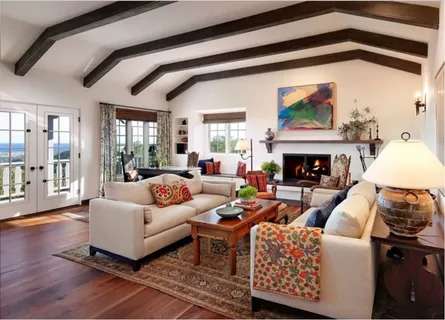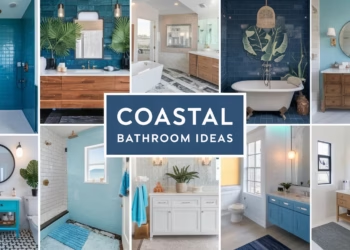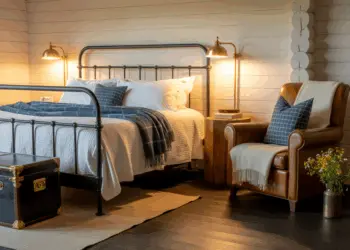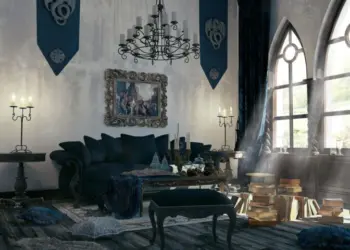Are you wondering what all the interior design styles are? Maybe you want to change your design but can’t decide which direction to go. There’s a style for every preference, and we’re here to help you find the look that’s right for you. Read on to find out what interior design styles are out there…
The idea behind this guide of different decorating styles is to give you an overview of current styles that exist and that you can use to furnish and decorate your home. There are others that I haven’t mentioned below, either because they’re old or out of fashion (Tudor, Directoire, Elizabethan), or because they’re better known outside our borders (Amish, Arts & Crafts, Chippendale, English Country) or difficult to use, such as the Cabinet de Curiosité or Art Nouveau styles.
Table of Contents
1. Interior design styles: Abstract style
Like expressionist abstract art, abstract design focuses on unique architectural elements, such as asymmetrical doors and furniture. It is similar to contemporary or modern style in that it uses clean lines, although abstract style in decorating also incorporates chaotic aspects to offer a fresh and unique perspective. This type of interior design lends itself to bright colors, such as yellows, blues and oranges. Use black as a contrasting element to create a striking effect. Tables, chairs, armchairs and sofas all have clean lines, but like the abstract style of interior design as a whole, these pieces are asymmetrical.

2. Interior design styles: African style
Inspired by nature, African style uses natural shapes, textures and finishes. This exotic style celebrates the imperfections of hardwoods, reeds and stone in its minimalist handmade furnishings. The palette is generally full of rich, warm colors like burgundy, orange and dark brown earth tones, with walls painted in textured beige, cream or white. Floors are often sandstone, terracotta or tinted concrete with sisal or jute rugs.
Animal skins such as zebra or cheetah often feature to emphasize the importance of wildlife in African culture. Triplolina chairs are emblematic of this aesthetic. Accents include hand-woven baskets, carved wooden bowls and ritual masks, stone artifacts and softly shaped poufs.

3. Interior design styles : Maximalist style
Maximalist-style interior design is the boldest style. It incorporates layers upon layers of bright colors, patterns, textures and meaningful elements. Minimalism takes your personal preferences and favorite artwork, furniture, treasures and decor and composes them up to ten by displaying them all, hopefully in a somewhat coordinated way.
This makes each maximalist-style interior incredibly unique to the person designing it! While “more is more” is the principle of maximalist design, it’s not just about adding more and more things, but about embracing your personality and favorite things and incorporating them into your interior design. The trick to mastering minimalism is to find your happy medium with a little focus and planning, so that it’s elaborate but not too overwhelming.
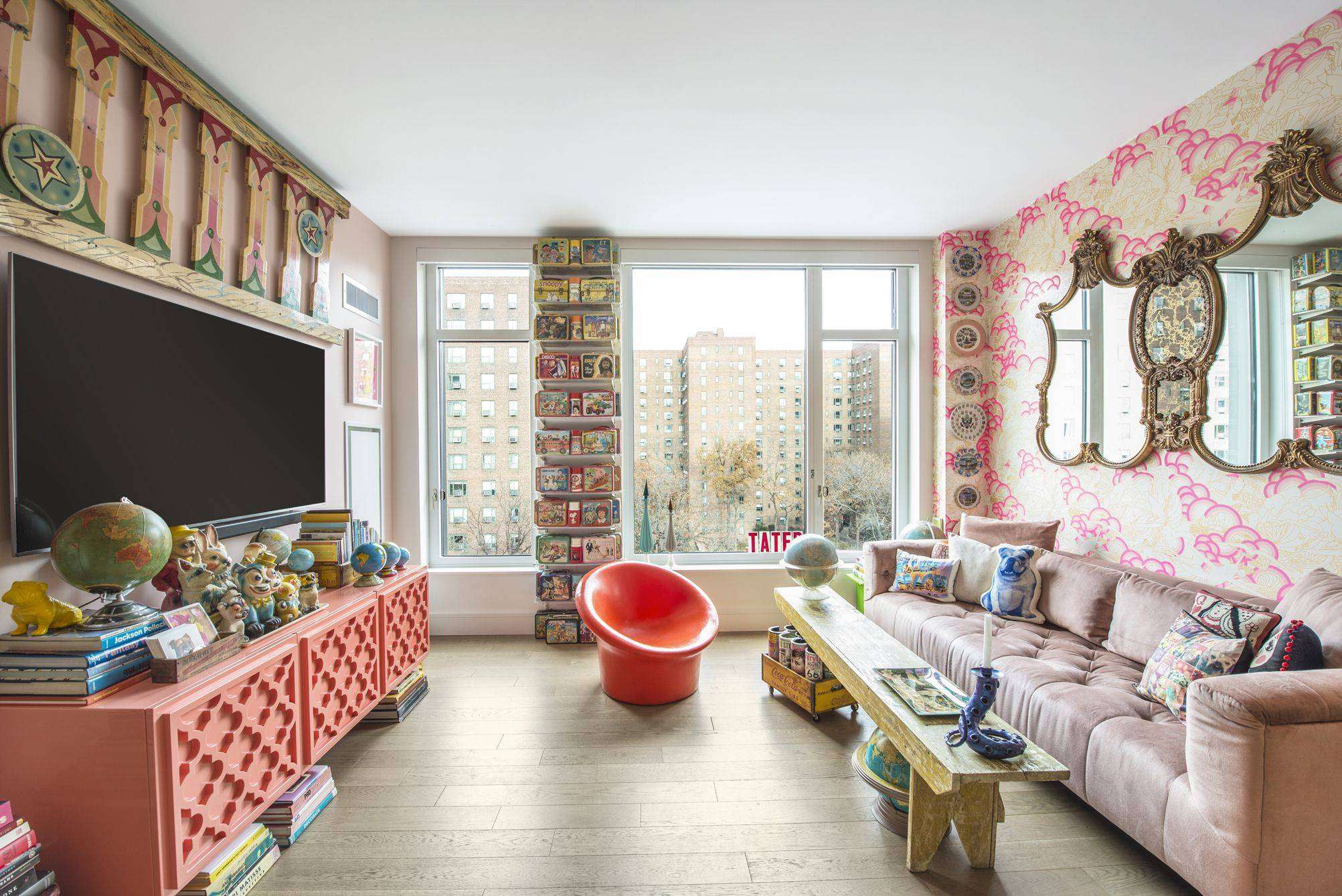
4. Interior design styles: Art Deco style
Inspired by French art and design of the 1920s, the art deco style (short for decorative arts) features sleek metallic finishes such as stainless steel, glass and chrome. Unlike vintage style, which highlights floral motifs, rugs and linens feature graphic prints such as zigzags, sunbursts, animal prints and geometric shapes. Generously-sized chairs, wardrobes, chests of drawers and sofas are all typical of the 1920s. Lighting fixtures are just as structured as the décor and furniture. They are generally made of elegant, shiny materials such as polished bronze, chrome or steel.

5. Interior design styles: oriental style
Oriental style combines lush materials, bright colors like turquoise and ornate patterns. Mixing and matching various textures and materials, such as metal fixtures, velvet sofas, wooden tables and glass decor, produces a charming and attractive effect in living rooms or bedrooms. Neutrals are the basis of oriental interiors, and colors like gold, silver, turquoise, pink and bronze add personality and whimsy to the space. Set the mood with suspended metal fixtures engraved with an intricate pattern to project onto the walls.

6. Interior design styles :Asian style
Asian interiors focus on clean lines and striking shapes, and often exude a peaceful, serene atmosphere. In Asian-style interiors, you’ll notice a reference to nature, with rooms containing pebble backsplashes, decorative greenery and stone sinks. There’s also an emphasis on natural design elements such as wood and concrete tiles.
Conceal storage by Versa tiling furniture, making it an effective style for small spaces. Sofas and armchairs feature silk cushions in a variety of colors and patterns. Lighting fixtures are elegant and practical. Intricately patterned table lamps are the perfect accessory for any room in the house.

7. Interior design styles :Baroque style
The Baroque style is associated with opulence, grandeur and luxury. Intricately designed furniture, gilded accessories and elegant materials such as marble and granite are characteristic of this European-influenced style. Architecture, decoration and furnishings are all symmetrical, and representations of shells frequently feature throughout the home. Irregular curves, elaborate scrolls, oversized moldings and twisted columns appear on pieces such as sofas, dining chairs, tables and cabinets to create a sense of movement. Lanterns and candles on wooden, brass and pewter supports are fixtures frequently used with this decorating style.

8. Bauhaus style
The German-derived Bauhaus style emphasizes simplicity evoked by clean lines. Functionality, a key element of this interior style, incorporated an appreciation of biological science. This ecological design was a unification of art and science, with the satisfaction of human needs at its core. For example, the choice of lighting depends on their style, as well as on how they respond to a room’s function.
Overall, Bauhaus furniture is incredibly flexible in its ability to adapt to the individual, their environment and their unique needs. Where you can fold many pieces of furniture and lighting, collapse or adjust to the particular requirements of each situation. Bauhaus is sober and features soft lines with a mix of organic materials (leather, glass and laminated wood).

9. Interior design styles: seaside style
The Seaside style evokes a light, airy feel, much like the ambiance you’d get from sitting with your toes buried in the sand. Generally, color palettes draw on coastal hues found in nature, such as sky blue, beige and bright white. You can incorporate bright, sunny shades like coral and turquoise give the space personality. Natural materials such as weathered wood and sea glass commonly found in this style.
To maintain the airy ambience, furniture is usually made of wicker or distressed wood. Chairs and sofas receive upholstery in lightweight materials like cotton or linen. Lighting fixtures exhibit a nautical touch. Wall lights can also consist of rustic copper or iron lanterns.

10. Interior design styles :Bohemian style
Bohemian-style interiors have a relaxed atmosphere and focus on nature, intricate patterns and bright colors like purples, reds and pinks. Frequently, designers combine all these elements to craft an eclectic and distinctive aesthetic. Boho style involves mixing interesting colors, trinkets, fabrics and various types of furniture without any intention of matching or adhering to a specific style, much like the nomads who inspired it.
You might see a contemporary sofa with striped upholstery next to a vintage velvet pouffe and a brightly colored chair. It’s the mix of different types of furniture that makes bohemian interiors so versatile. Lighting fixtures are just as unique as the furniture.

11. Interior design styles: English Colonial style
Inspired by the décor prevalent during the colonization of Africa, Asia and the West Indies, English colonial interiors feature light cotton fabric on curtains and bedding. The most common color palette includes a mix of whites, beiges and browns to produce a sober, subtle look. To infuse a fresh ambiance, designers consistently employ flowers and plants throughout the room.
Furniture is composed of materials such as wicker, ebony, teak and mahogany. Leather travel trunks with brass latches and rivets were popular items at the height of this era. Tables, chairs, wardrobes and sofas, generally built with dark-colored wood to create a rich, sophisticated ambience. Deeply colored furniture provides a nice contrast with neutral-toned walls. Bell lanterns and illuminated ceiling fans are popular fixtures in this decorating style.
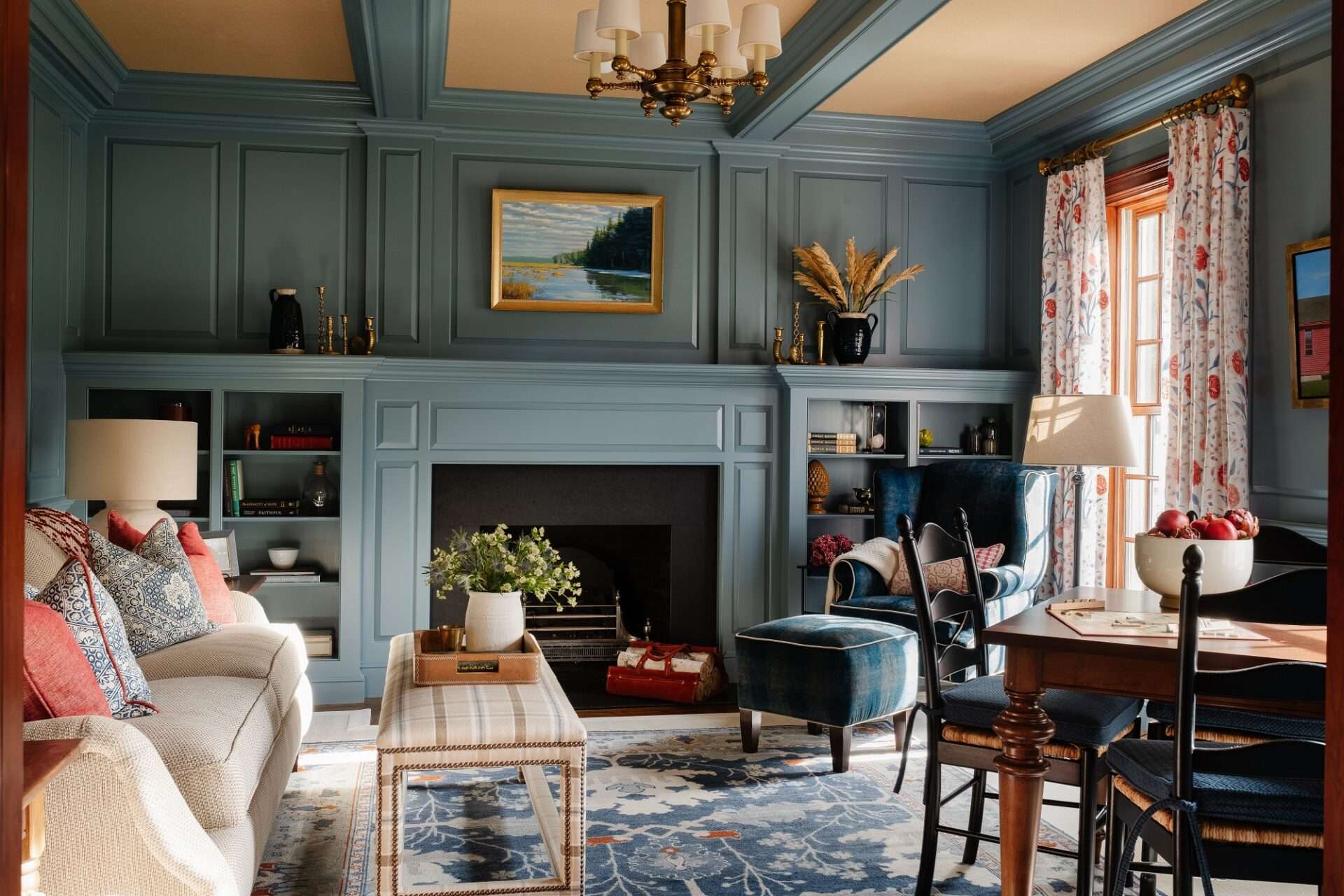
12. Interior design styles: chinese style
Chinese style homes draw inspiration from Asian and Zen design, prioritizing the importance of nature and simplicity. The interior features bursts of bright colors including gold, red, brown, and black. The arrangement of furniture and decor in accordance with Feng Shui principles creates positive energy in the home. Cabinets and chairs have intricate designs of dragons, mountains, clouds, birds, and flowers. They also have a shiny lacquer coating. Colorful lanterns provide light and add texture to the room. You can also add fancy chandeliers.

13. Coastal style
The Coastal Style creates a relaxed, subdued, and carefree atmosphere. Decor elements inspired by the beach, such as sea glass and driftwood, are used. A color scheme of predominantly white is typical, with occasional pops of blues, greens, and coral. The furniture creates a lively vibe by the seaside. So, there are often chairs and tables made of painted wood with a vintage finish or a natural woven wicker chair. The light fixtures also use natural elements to maintain the beach ambiance. Chandeliers made of cascading sea glass petals or hanging wooden pendants are suitable for the coastal style.

14. Interior design styles: contemporary style
But there are a few differences. Unlike its modern counterpart, contemporary style borrows from different eras, creating an eclectic environment. Unlike its modern counterpart, contemporary style borrows from different eras, creating an eclectic environment. For example, simple, elegant furniture and artwork combine with detailed moldings around walls and windows. Contemporary style also takes note of the home’s minimal design, as layouts are open and airy with no clutter in sight.
Furniture has sharp 90-degree angles and features simple fabrics such as wool, cotton and linen without embellishments or patterns. Sofas, chairs and stools come in neutral colors such as black, white and beige. Lighting fixtures are made of pure materials such as glass, ceramic, polished nickel or steel.
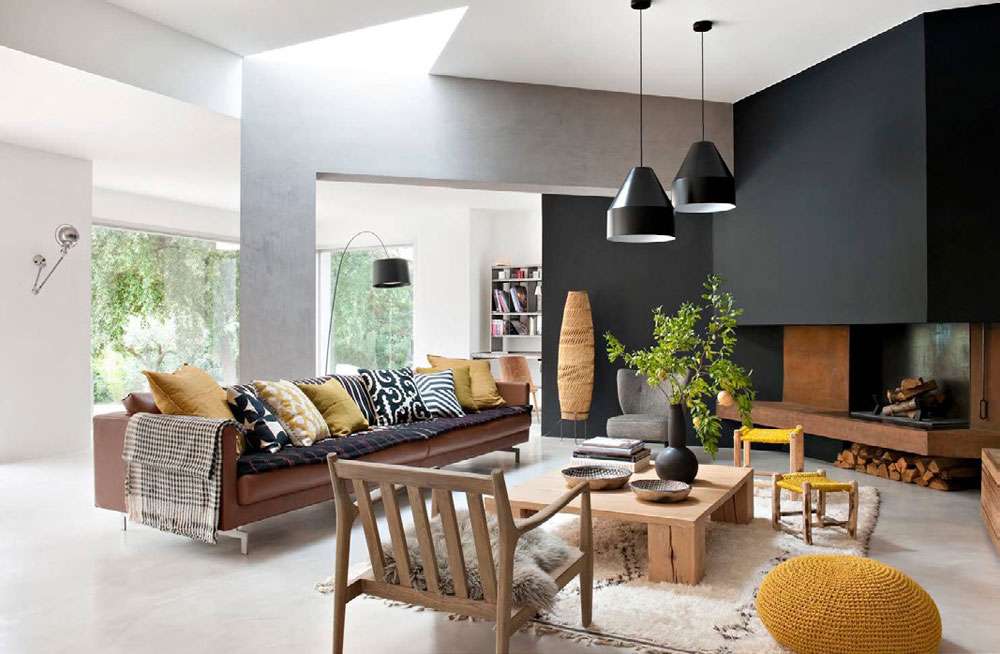
15. Interior design styles: English style
The English style reflects pride in the United Kingdom, so the British flag (aka Union Jack) gets frequent inspiration. This 1960s pop-culture-inspired style was at its peak in the 1990s. Use various shades of red, white and blue subtly. For example, a warm brick fireplace, cream-colored walls and blue-toned armchairs or cushions bring this style’s color palette to life. Original accessories and artwork add a touch of personality to this style. Cushions can feature bold red, white and blue patterns or solid colors. You can see leather sofas and armchairs. Vintage accents are also used.
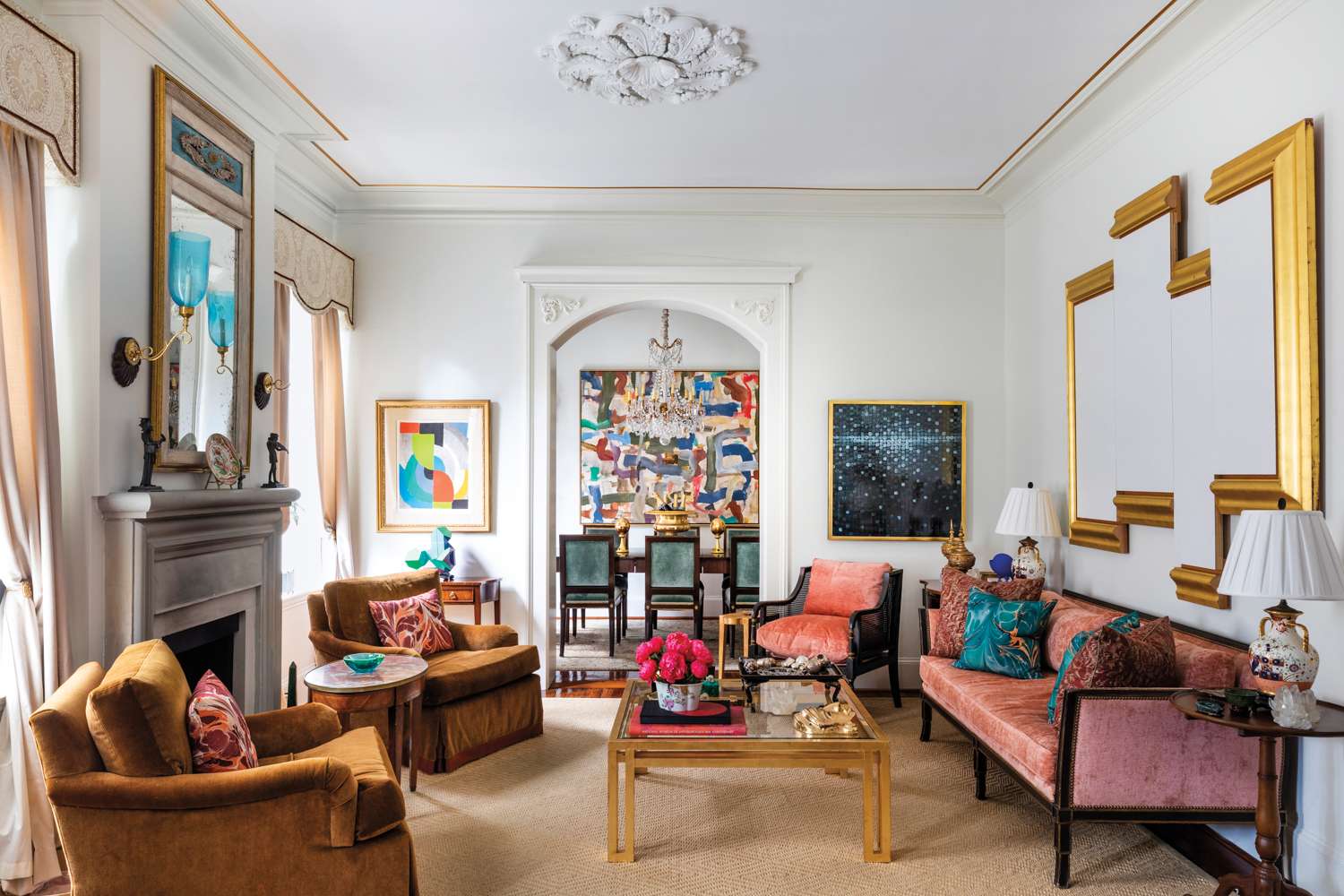
16. Interior design styles: cottage style
Described as comfortable and comforting. Like the coastal style, cottage interiors evoke a light, airy feel. Instead of heavy curtains, light fabrics such as lace and cotton are used. Weathered woods, distressed paints and a color palette of whites and creams combine to create a warm and welcoming informal home. Vintage fixtures and accessories such as chandeliers, farmhouse sinks and ornate rugs are using to create a charming farmhouse aesthetic.
Chairs and sofas can be dressed in bright pastel hues that reflect the sea and sky. Woven rugs sit under furniture to maintain the relaxed nature of the home. Wooden planks add character to walls, ceilings and floors. Accentuated natural light illuminates the home, with vintage chandeliers and weathered pendant lights providing additional illumination.

17. Interior design styles :Country house style
The country house style shares similar characteristics to the cottage style. It uses soft colors and vintage accessories throughout the home. Flea markets and antique stores provide inspiration for furniture and decorative pieces. Fabrics on drapes, curtains and bedding often feature floral patterns, gingham, large checks or stripes to give personality to the otherwise understated color palette.
Furniture is constructed from warm woods such as pine and oak, and features clean lines with little ornamentation. Wooden tables, chairs, cabinets and chests of drawers generally have a worn, painted finish. Metallic accents are enhanced by fixtures such as bronze wall sconces or copper lanterns. Painted or terracotta jars are often used as decorative containers on open shelves.

18. Eclectic interior design style
The eclectic interior design style encompasses many styles such as modern, vintage and bohemian. Also mixed and matched with variety of materials and textures: you might see a leather sofa combined with a “plush” rug, a weathered wooden table, wrought-iron pendants and chrome wall decoration. Unlike minimalist styles, often filled with various knick-knacks, such as vintage crockery, modern sculptures, flower vases and so on.
Decorating with the eclectic style involves using a number of different textures, colors and styles for a unique environment filled with personality. Despite the variety, this style is not chaotic or random. There are consistent patterns and themes that tie disparate pieces together. We use often a common thread such as a neutral shape or tone to subtly link the varied pieces and create a sense of belonging.

19. Interior design styles: Egyptian style
The Egyptian style uses rich colors to create a truly opulent atmosphere. Metallic golds and vibrant blues, oranges and yellows are combined with neutrals for the perfect balance between bold and subtle. Walls are often painted in different shades of yellows and soft browns to create a warm ambience, reminiscent of the sand that prevails in the deserts of Egypt. This light, neutral palette provides an understated backdrop for the contrasting boldness of the upholstery and vivid accents.
Fabrics are made from Egyptian silk and cotton, and are solid-colored and generally devoid of ornate patterns. Furniture is largely geometric in shape, but features detailed ornamentation on corners and edges. Flat surfaces are often decorated with geometric reliefs, colored enamels or gilded inlays. Egyptian-inspired art (gilded metal sculptures, papyrus scrolls and hieroglyphs) is also used. Greenery is sparingly placed throughout the room for a touch of color.

20. Interior design styles: Empire style
The Empire style represents the second phase of neoclassicism, which began in early 19th-century France and later appeared in the United States. It marked a return to the ostentatious splendor of Imperial Rome after the minimalist austerity of the earlier Directoire period. Columns changed from simple Doric to ornate Corinthian. This opulence is reflected in the detailed ebony carvings, richly veneered mahogany and intricate ormolu accents and carvings.
There’s a symmetry to the ornamentation of the Empire aesthetic, which frequently includes eagles, stars, chariots, winged chimeras, laurels and acanthus leaves. Egyptian iconography such as sphinxes, pyramids, obelisks and scarabs also adorn decorative engravings and inlays. Oversized chests and cabinets often feature animal paws, glass handles and gilded brass brackets. Seating is wide, with low backrests and curved lines.

21. Interior design styles: flemish style
The Flemish style borrows elements from Dutch Renaissance houses. The aesthetic is simple and uncluttered, yet retains a luxurious, calm ambience. Traditional furniture is characterized by the Flemish foot, which ends in an S or C shape and is richly carved. Furniture is generally heavy and dark, often with detailed upholstery. Color is rarely used and interiors appear somewhat bare, similar to a rustic home. Aged rough wood and exposed brick are visible in all Flemish-style interiors.

22. Provençal style
This relaxed style is mainly influenced by the rural home in the south of France. The Provençal style is all about creating symmetry and balance in the home. This style can suit both formal and casual tastes, as it combines both elegant and country elements. These homes are typically built of brick, stone or stucco, and these materials are often found inside the dwellings as well as on the accent walls. More casual Provençal homes use a subtle color palette of blues, yellows, pinks and whites for a mix of glamour and whimsy. Provençal interiors sometimes feature arched doors, windows and entrances that add to the stately elegance of the Provençal style.
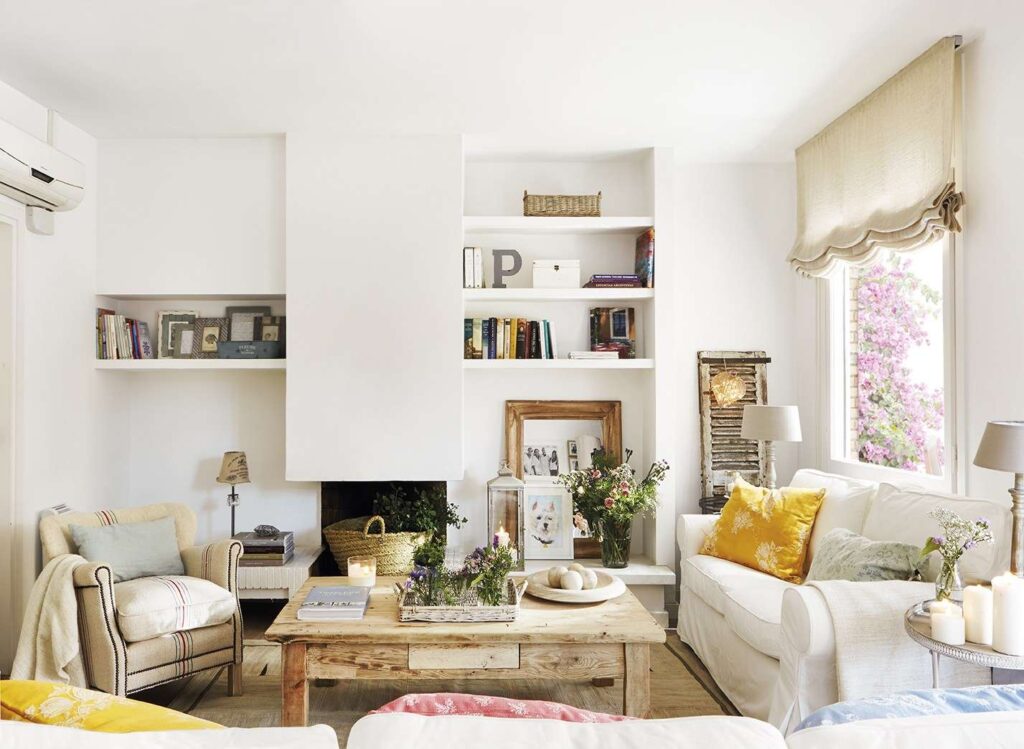
23. Georgian style
Like the Provençal style, the Georgian style places a strong emphasis on harmony and symmetry. Wooden chairs in the kitchen and dining room feature richly carved legs. Moldings are equally intricate, and even ceilings feature detailed motifs. Color palettes are often light and understated, combining sky blues, soft grays and pastel pinks. Fireplaces are the focal point of the living room. Large chandeliers in metal, wood or glass can also be found in the living room. Silver or brass lighting fixtures line the walls to provide extra light.

24. Gothic interior design style
This medieval design style is an offshoot of Romanesque architecture. Gothic interiors give the impression of a medieval castle. Perhaps the most distinctive element of the Gothic style is the pointed arch: doors, entrances and windows are all in this emblematic form. Vaulted ceilings and buttresses create a striking interior space. Contrary to popular belief, the Gothic style isn’t all about embracing the dark. In fact, many interiors feature rich, dark purples, reds, greens and blues. However, these colors are used sparingly, such as on accent walls, appliances and backsplashes. And sometimes in stained glass or rosettes.

25. Interior design styles: greek style
The Greek style shares similar characteristics with Egyptian homes. In more luxurious residences, elements such as fittings and fixtures are gilded. The iconic Greek key motif (aka meander pattern) can be seen throughout the home on everything from tiles and curtains to rugs, pillows, sheets and wallpaper. Greek decor exudes a subtle Mediterranean touch, thanks to the use of warm beiges and deep blues.
Think of the simple yet picturesque houses that adorn the ocean cliffs of the island of Santorini. Ceilings are high, with whitewashed textured plaster walls. Furniture is typically cast iron, wood and wrought iron. Designs tend to feature simple lines and gentle curves.

26. Indian style
Similar to Oriental style, Indian interiors feature rich, exotic colors and textures. Imagine dark red walls combined with copper pillars and a red leather pouffe. Furniture is usually handcrafted and richly carved from solid wood. Chairs and tables traditionally feature curved arms and legs. Brightly painted cabinets are often embellished with decorative inlays of stone, metal, mirrors or ivory. Informal seating in Indian homes often incorporates footrests, diwans or even luxurious jhoola swings.
Natural fiber fabrics such as khadi are used to cover dining chairs, while rich silk and ikat highlight accent and centerpiece pieces. Woven and embroidered rugs and floor cushions are widely used in Indian homes. Colorful tapestries depicting flora, fauna and mandalas are used for cushions and blankets.

27. Industrial style
Industrial-style interiors exude a cool, modern vibe. The style mixes new and reused items for a unique combination of modern and vintage. Industrial design is characterized by uncluttered open spaces: every room, from the kitchen to the basement, contains high, spacious loft-like ceilings. Color palettes are kept cool and understated: you’ll often see a mix of grays, blacks and whites complemented by touches of blue or green.
Metal is the material most often used in industrial design. It offers rugged charm and can be used on everything from light fixtures and countertops to stairwells and faucets. This has become the style of choice for urban lofts that were once factories, schools or other old buildings with exposed brick and rafter ceilings.

28. Interior design styles :Italian style
Italian-style interiors are filled with natural hues such as off-whites and beiges. Touches of Mediterranean colors such as brilliant blues, rich greens, burnt oranges and soft yellows also make an appearance. Natural light is brought into the home to enhance the vast color palette. This style is characterized by a natural look: stone, slate and granite are used throughout the interior on countertops and accent walls.
Richly detailed terra cotta and mosaic tiles are used in backsplashes to provide a brightly colored accent. This style features open spaces with large windows that let the outside shine through and are mirrored by assorted potted greenery inside. Ornate wrought iron is often used on railings and balconies.

29. Interior design styles: Japanese style
Japanese-style interiors exude a serene, peaceful feel thanks to a simple design style. Like minimalist design, Japanese interiors emphasize uncluttered spaces, clean lines and balance. Sliding doors are often used to create a harmonious transition from one room to another. Natural wood and stone are used extensively throughout the home. Outdoor elements such as rock gardens, fountains, ferns, bonsai and bamboo are also used.
Furniture is large and usually square or rectangular, and seating is often flush with the floor. Shojis are essential design elements in traditional Japanese homes. These sliding doors or room dividers have a light wooden frame and are made from translucent washi paper that lets light through.

30. Medieval style
Medieval interior design can be compared to Gothic interiors, as it tends to have similar design elements such as rich wood accents and decorative stonework. Like medieval castles, medieval-style interiors are rich in detail, with large, heavy and richly carved wooden benches, chairs and tables. Fabrics are luxurious, such as velvet, silk and damask. Bold medieval color palettes: dramatic reds, greens, golds and blues can be seen everywhere, from upholstery fabrics to rugs and other decorative objects. Walls in this style are often adorned with rich tapestries suspended from metal rods.

31. Mediterranean style
Like Greek interiors, Mediterranean style is influenced by location. Touches of Spain, Greece and Italy can be found in these interiors, and these places are enlivened by bright, bold colors influenced by the sea and sky, such as turquoise, emerald and yellow. Decorative mosaic tiles are often used on interior elements such as floors, tabletops, counters, mirrors and backsplashes to bring rustic charm to the home. Mediterranean furniture is short and low to the ground. Furniture legs are richly detailed. Wrought-iron railings and balconies are popular features.

32. Memphis style
The Memphis style is colorful and abstract, with atypical shapes and asymmetry focused on form rather than function. It is intended to provoke an emotional response, and this outrageous contemporary aesthetic was once described as a “shotgun wedding between Bauhaus and Fisher-Price”. It is inspired by Art Deco and pop art, as evidenced by the frequent use of black and white stripes, zigzags and bold color contrasts. Notable elements of the Memphis style include Sottsass’s Ashoka lamp and Carlton bookcase, as well as Paola Navone’s Panda wardrobes.

33. Mexican style
Mexican-style homes offer a similar feel to eclectic interiors. Many bright colors are used, such as vivid pinks, greens, oranges, reds and yellows. Candlesticks, ceramic pots, ironwork and rugs also add personality. Pottery often features intricate, colorful patterns influenced by Mexican flora and fauna. Chairs, tables and sofas display an elegant look, with influences from Spanish colonial and Tuscan styles.
Prints and patterns can be found on everything. Many Mexican kitchen and bathroom backsplashes feature traditional hand-painted Talavera tiles. This colorful tin-glazed majolica pottery was popular in Mexico’s monasteries and churches in the late 1600s and early 1700s.

34. Different interior design styles: Mid-Century Modern style
Mid-Century Modern-style interiors have a continuous flow from inside to outside thanks to sliding doors, bay windows, skylights and patios. Windows are often left bare to showcase exterior views. Furniture is unique, with standout pieces such as egg-shaped chairs and improbably shaped sofas. Many pieces, such as the Noguchi table, are asymmetrical and feature amorphous components, making them look more like sculptures than furniture. Elements such as floors and ceiling beams are stripped back to their original form, while walls are covered with graphic wallpaper in bold geometric patterns.

35. Interior design styles: Minimalist style
Minimalist-style interiors are free of clutter, displaying only elements such as sofas, tables and light fittings that are essential to functional living. Minimalist interiors emphasize simplicity and effortless beauty. Character is not provided by detail, but by natural materials and essential elements. Rooms are monochrome, usually with subdued neutrals.
Walls are simple, with only one or two decorative pieces, such as a canvas or mirror. All surfaces, from kitchen to bathroom, should be uncluttered. Furniture features clean lines with very few details, and is often used for storage, such as poufs that open to reveal the space.

36. Mission style
Mission-style interiors feature furniture inspired by the Arts and Crafts movement. Chairs, tables and desks have no detail or decoration and are very simply constructed. Legs are straight and chair backs feature a slatted design. Furniture is generally made of solid wood (usually oak). Interior color palettes are monochromatic, and cream is a popular color in the mission style because of its simple backdrop that blends well with wooden furniture.
Wallpaper is also used sparingly, featuring nature-inspired motifs such as flowers and vines. This style is named after the furniture that occupied the Spanish missions in California during the colonial period.
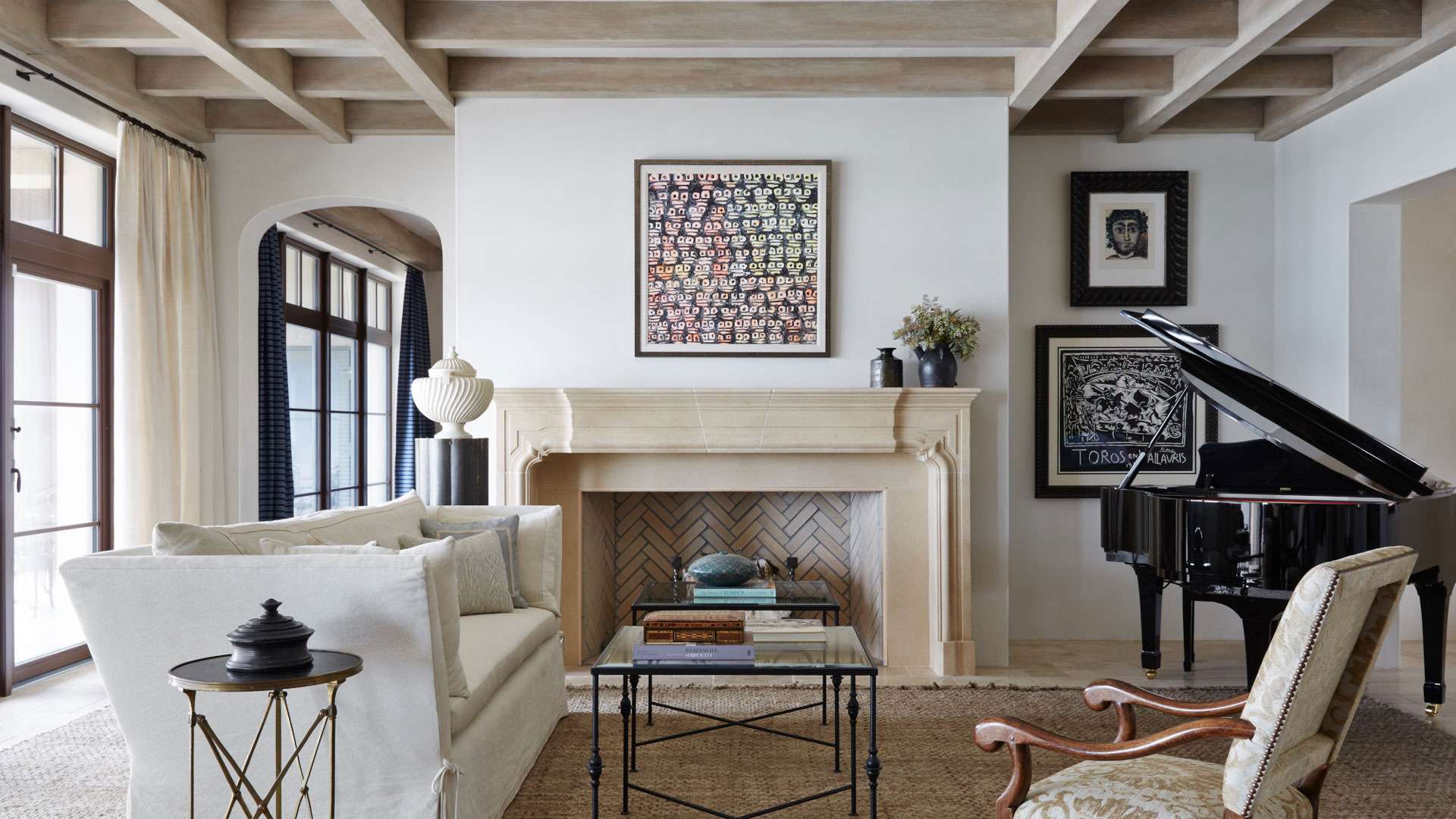
37. Interior design styles: Modern style
Modern-style interiors share similar characteristics with minimalist interiors. The emphasis is on simplicity, cleanliness and the absence of decoration or detail. Furniture features soft, clean lines inspired by the architecture of the 1930s. It is this testimony to the sensibility of the Bauhaus movement and the principles of Scandinavian design that distinguishes modern interior design from contemporary style. Color palettes are generally composed of neutral shades, such as whites, creams and beiges.
However, unlike minimalist interiors, these homes contain touches of bright colors such as oranges, pinks and turquoises on things like crockery, curtains and carpets. All the electronics of modern interiors are simplified, so living rooms contain built-in DVD players and kitchens are equipped with small flat-screen TVs. Plastic and plywood are frequently used in furniture of this style.
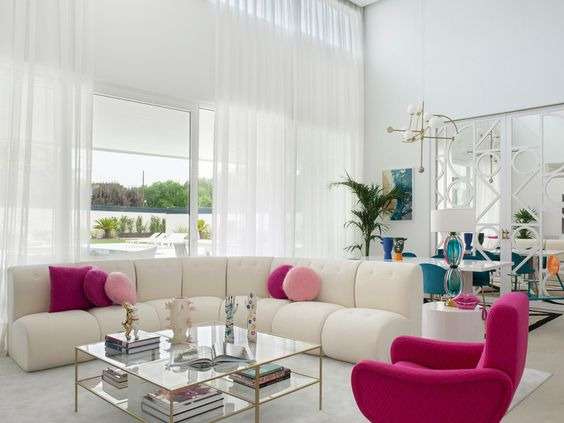
38. Moroccan style
Moroccan-style interiors can be compared to bohemian and eclectic decorations, as Moroccan home design combines a variety of colors and patterns to give character to a space. The shades used in Moroccan interiors, however, are mainly deep tones like emeralds, royal blues and bold purples: vibrant reminders of the colorful markets of ancient Marrakech. Furniture is richly carved with wood accents and upholstered in luxurious fabrics like silk and velvet.
Fabrics feature colorful mosaic patterns and interiors are lit by intricately detailed metal lamps. Ceramic or terracotta floor and wall tiles are frequently used in kitchens and dining rooms, or in mosaics. Brightly colored rugs, poufs and cushions add an exotic yet casual opulence. Low seats and coffee tables are also hallmarks of Moroccan design. The feeling of relaxation is completed by soft cushions and an abundance of leafy green plants.
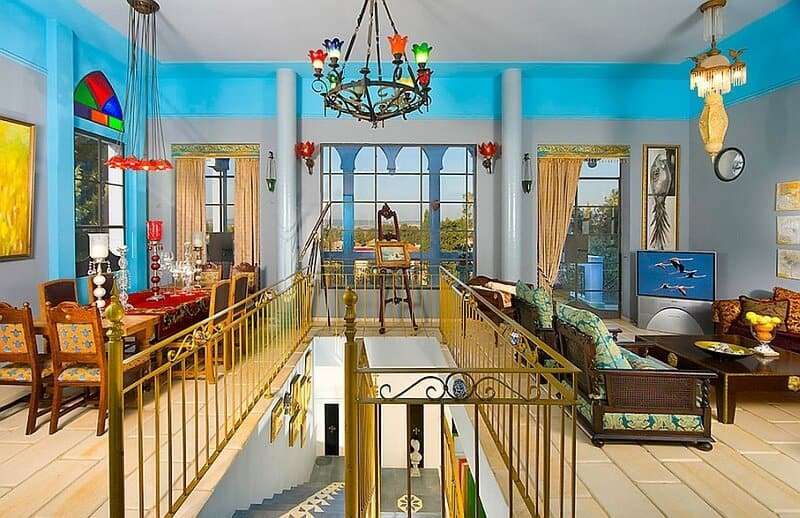
39. Interior design styles: Parisian style
Parisian-style interiors offer a blend of old and new for a unique, eclectic aesthetic. Traditional and modern elements are combined: for example, flea market finds such as a vintage clock or lamp can be paired with a simple, sleek modern sofa. Walls are white to maximize natural light, and the colors used on furniture and decor are darker and richer to create a striking contrast.
Rugs and chandeliers are an integral part of the Parisian style. Rugs are usually patterned and feature a bold color to contrast with white walls. Vintage chandeliers can be found everywhere, from the kitchen to the bedroom, and offer a touch of glamour. Authentic bathrooms may feature a freestanding clawfoot bathtub with a small side table.
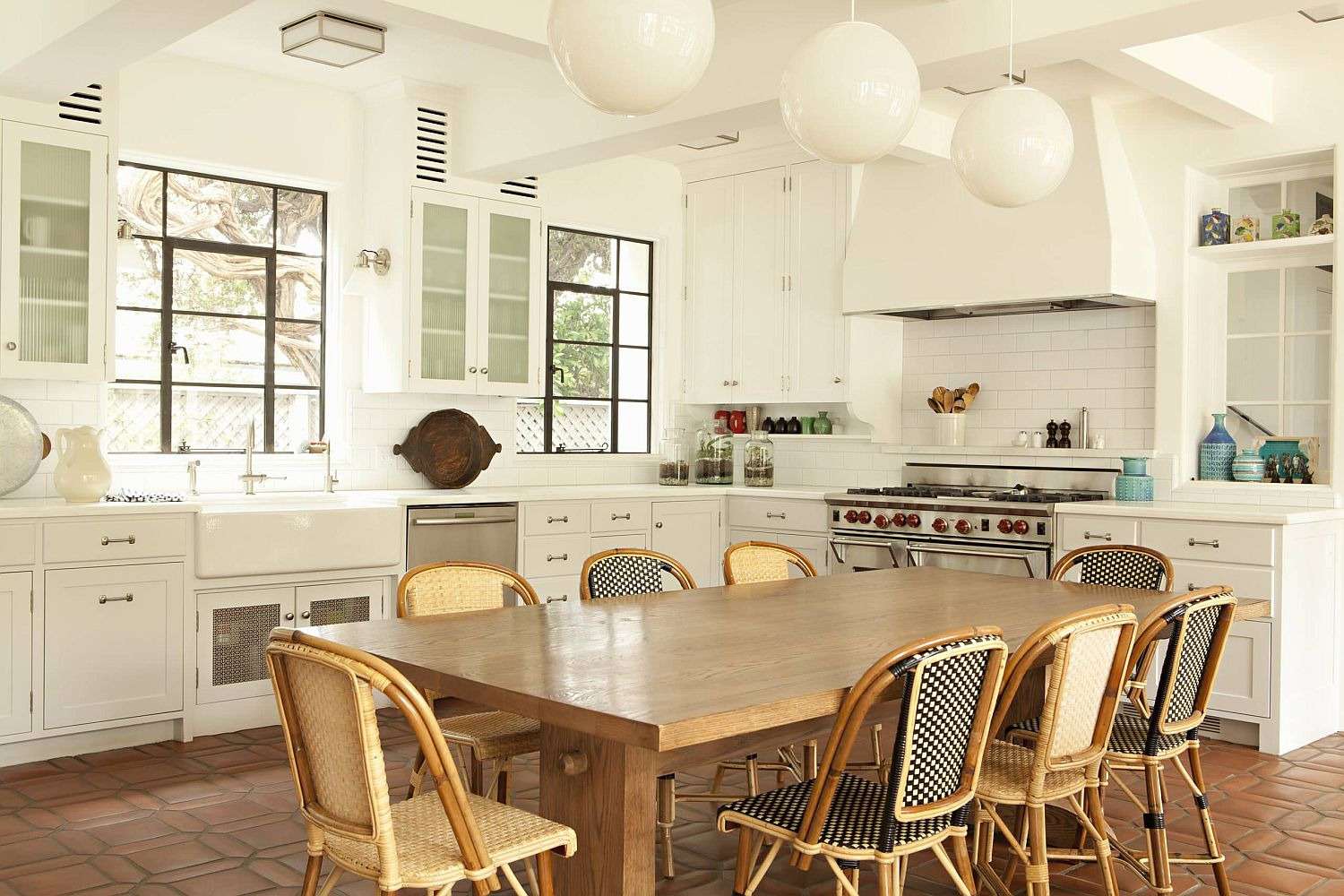
40. Organic style
Organic-style interiors are sleek and relaxed, highlighted by a neutral color palette, warm woods and natural shapes. Materials used in these interiors are found outdoors and include stone and local wood. Where artificial surfaces are used, textured patterns are implemented to produce a natural, earthy feel. Interior and exterior are blended through the use of glass. While the main color palette found in these interiors consists largely of neutrals, bold splashes of color are used sparingly to wake up the interior. Plants also help to add life to the space.
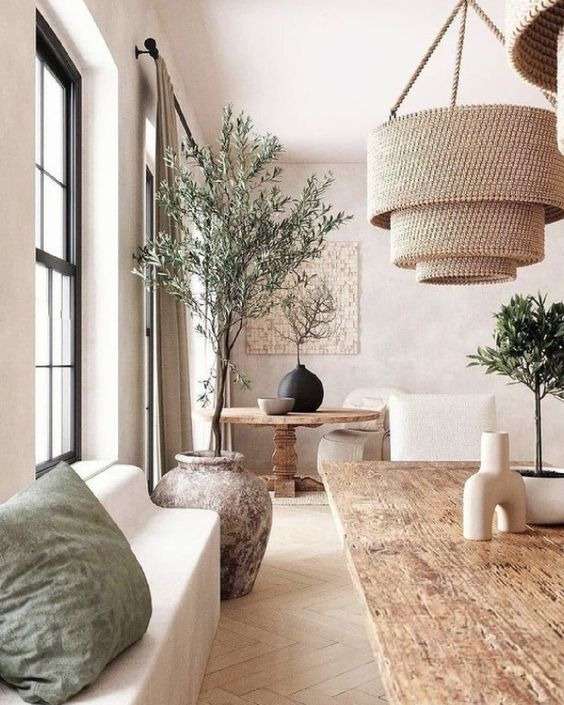
41. Interior design styles: Retro style
Retro-style interiors have nostalgic elements of vintage, eclectic and bohemian styles. Perhaps its most defining quality is the use of bold patterns and colors that celebrate the lightness of post-war America. Shades are bright and vibrant, and may include a mix of orange, red, yellow and so on. As a rule, only one or two of these colors are used to avoid a chaotic result.
Patterns are always large and are used on everything from walls and rugs to chairs and sofas. Furniture features circular and curved lines and is constructed from wood or leather. Trinkets found in antique stores and flea markets are arranged on open shelves to add a vintage touch and personality to the home. The 1950s and 1960s are the periods most often associated with this style.

42. Rococo style
Also known as rocaille, the Rococo style was a reaction to the formal geometric style of the Louis XIV style that preceded it in France. Rococo interiors are light, elegant and airy. The color palette consists mainly of ivory, light pastels and gold. Mirrors are a decorative tool commonly used to enhance natural light and make spaces appear larger.
Rococo furniture is defined by elaborate hand carvings made by craftsmen and owes much of its inspiration to its Baroque ancestry. The lines on tables, chairs and sofas are always curved and soft. Asymmetrical decorations are another big part of the Rococo style, and are usually inspired by elements of nature such as conch shells, waves, corals and seashells.
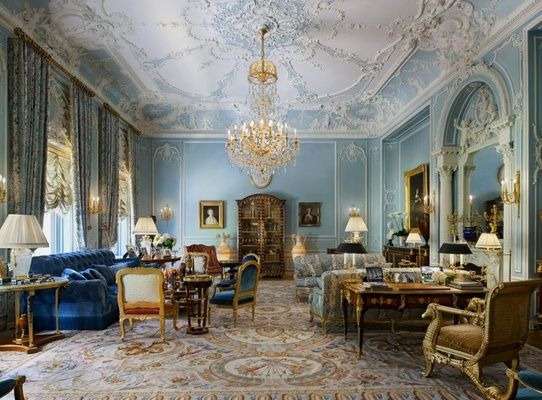
43. Interior design styles: Romantic style
The romantic style embraces a soft, delicate and beautiful feel. Colors are generally muted and subdued, and include shades such as pastel pink, sky blue and creamy white. Metallic elements such as frames, candlesticks and vases offer a sparkling contrast to the understated palette. Antique chandeliers with crystal droplets hang in living rooms, dining rooms and bedrooms to add a touch of glamour.
Aggressive lighting doesn’t exist in rooms with a romantic aesthetic, as the creation of ambiance relies on diffused lighting that idealizes rather than completely reveals. Four-poster beds with fabric garlands give a fairytale feel and create a sense of intimacy. Furniture lines are graceful and sinuous to promote a romantic ambience.

44. Russian style
Russian style can be defined as comfortable and welcoming. It blends both classic and country interiors for a perfect mix of luxury and simplicity. These spaces are filled with handmade wall decorations and artisanal furniture. Panel cabinets may feature folk art or geometric symbols, while framed tapestries pay homage to traditional Russian craftsmanship.
Colors used in Russian interiors include inviting hues such as mint greens, creamy whites, golden yellows and dark browns. Flowers are an often-used decorating tool: floral motifs are found on curtains and pillows. Curtains are hung on walls and flowers in vases add charm and brightness to the room style. Wooden floors or decorative ceramic tiles add extra flavor to this decorating style.
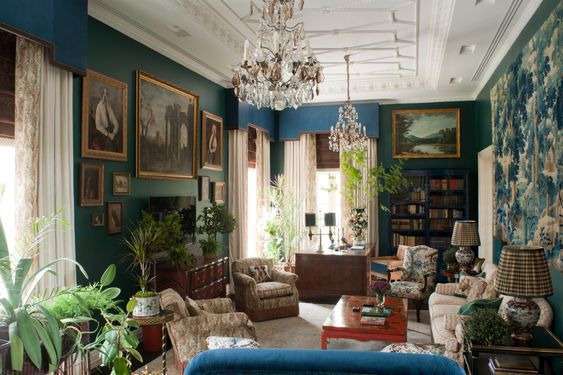
45. Rustic style
This design style was born of the natural inspirations of the Romantic movement. Rustic interiors are inspired by the simplicity and rugged beauty of nature. Furniture and fabrics are composed of materials found outdoors, such as wood, stone, concrete, hemp, wool and cotton. Interiors are filled with neutral colors to draw attention to the gorgeous raw materials used to create floors, accent walls, tables and chairs.
Walls are kept white or covered in warm brick, stone or wood. Large windows are another common element of rustic decor design, as they fill the space with natural light and help the interior feel as close to the outdoors as possible. The Adirondack chair is one of the most popular pieces of furniture identified with this style.
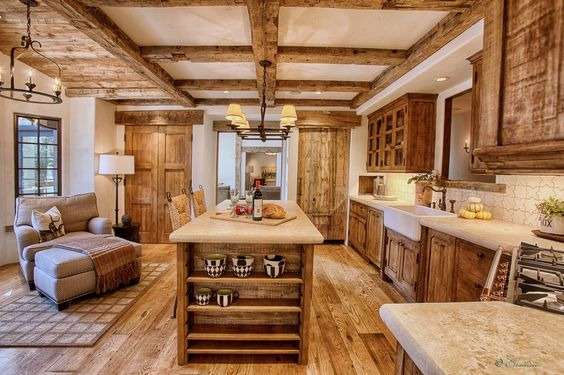
46. Interior design styles: Scandinavian style
Scandinavian-style interiors bear some resemblance to Russian and rustic interior design styles. It can be defined by its simplicity, the use of clean lines and natural materials. Hardwood floors are used in all rooms except the bathroom. Floors are always light in color, as is the rest of the house. Walls are generally white or gray, and blue textiles are used on sofas, rugs and bedding to bring a touch of color into the home.
Scandinavian minimalist furniture and architecture feature clean, simple lines. Typically Nordic fireplaces are usually the focal point of a room, warming the interior and providing a warm contrast to the soft colors.

47. Interior design styles :Shabby Chic style
The Shabby chic style presents a balance between rustic and glamorous interior design styles. Its name is attributed to London designer Rachel Ashwell, who was inspired by precious “finds” she discovered at flea markets. Furniture in this style looks worn and aged with painted layers. Fabrics for sofas, bedding and curtains are usually cotton and feature white or pastel colors to give the room a soft, delicate look.
Materials commonly used include weathered wood, wrought iron and wicker. Kitchen tables are constructed from wood and have a textured rug underneath. Tables are set with vintage teacups and linen napkins, and vintage chandeliers illuminate the room. Overall, an airy, seaside vibe can be found in shabby chic interiors.
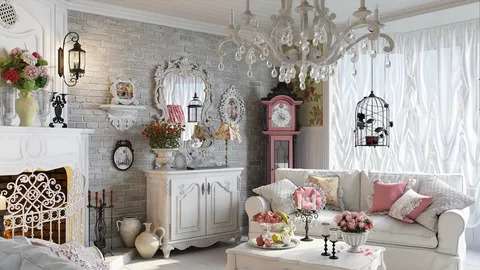
48. Interior design styles :Steampunk style
Steampunk style blends elegant interiors with industrial or mechanical styling. It features materials such as leather, dark wood and brass and bronze. Furniture has an industrial style, as tables, chairs and sofas are constructed from reclaimed wood and metals in addition to leather upholstery. Old maps are a frequently used decorating tool and can be hung as murals to add a vintage feel to an interior.
Exposed materials such as pipes, concrete walls and weathered wooden beams only add to the charm of steampunk interiors. Its origins date back to the turn of the 20th century, and are said to be inspired by the literary works of Jules Verne and H.G. Wells.
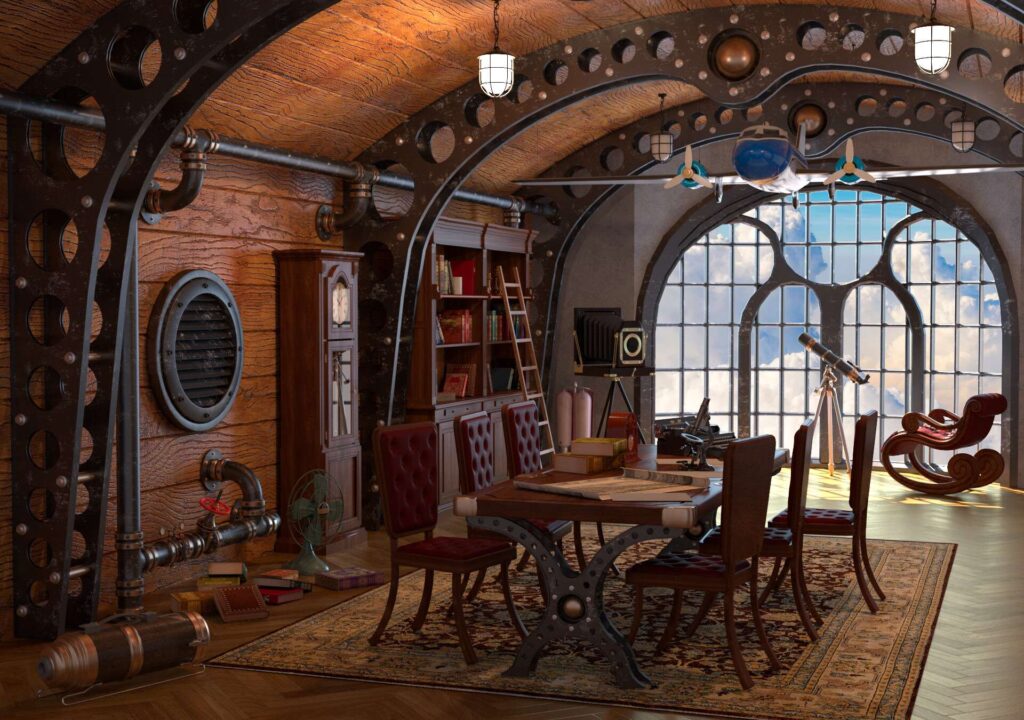
49. Traditional interior design style
A traditional-style interior will be filled with furniture from a variety of period interior design styles such as Tudor, Regency, Louis XV and Georgian. However, unlike eclectic interiors, traditional-style homes have a much more distinct visual cohesion in color palette and materials. Tables, chairs and sofas are generally made from dark wood and are richly detailed with carvings and curves. Windows are similarly designed, with scalloped edges, fringed accents and luxurious curtains brought together with tasselled cords.
Fabrics feature a variety of different patterns, including damasks, florals, stripes and plaids. Colors are soft and subdued to create a calm ambience throughout the home. Rooms are lit by sparkling crystal chandeliers and silver candelabras offering a warm glow. Fresh or silk flowers in vases and still-life oil paintings are often used as decorations.
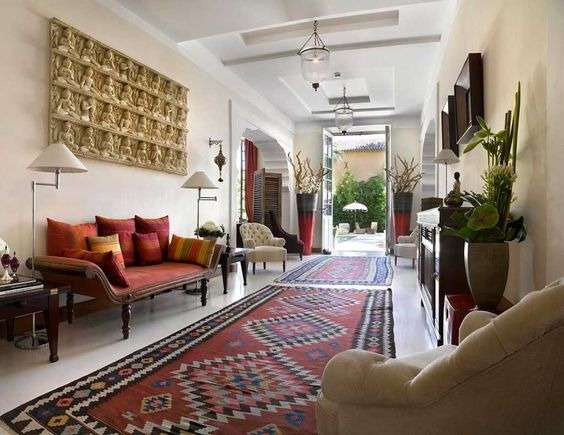
50. Transitional interior design style
Transitional style blends a variety of different styles to create a timeless look all its own. Because there’s a mix of traditional and contemporary design, furniture can feature straight, sophisticated lines, or have rounded lines with ornate carvings. Pieces such as chairs, tables and sofas balance masculine and feminine attributes to create a welcoming ambience. For the most part, however, the furniture has far less ornamentation than is found in most traditional interior design styles.
Furniture is covered in graphic patterns and textured materials such as cotton, leather and velvet. Lighting is elegant, as are sofas, tables and chairs. Wall sconces, pendant lights and table lamps have straight lines with a modern touch. Colors are similar to traditional design: dark browns, taupes and creamy whites.
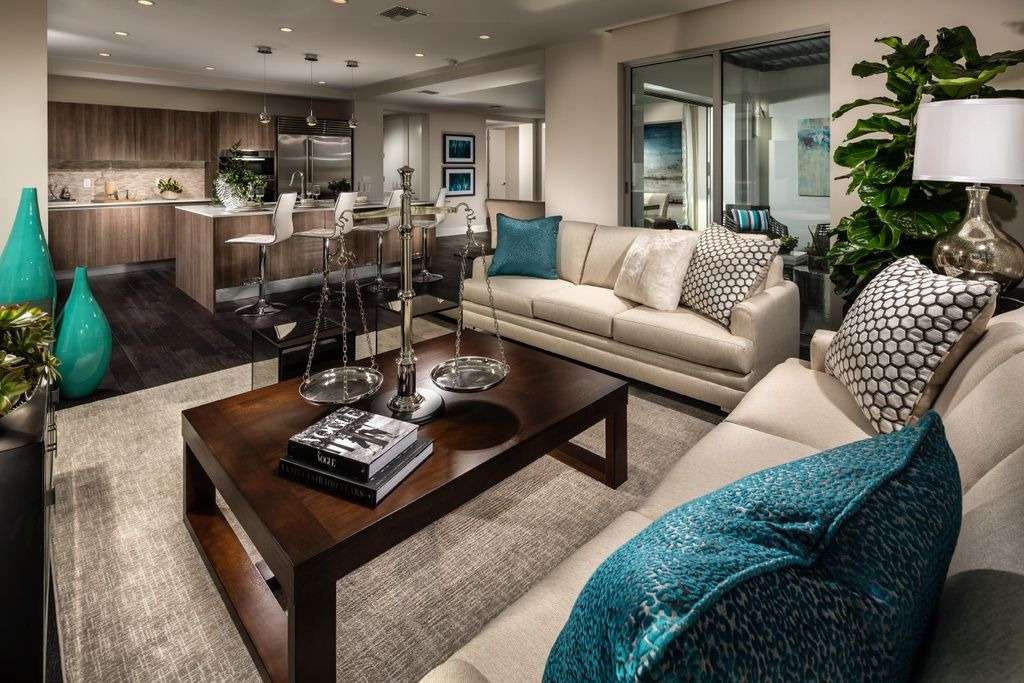
51. Interior design styles: Tropical style
Bring the islands into your home with a tropical style, combining influences from places like Hawaii and Polynesia. Furniture can be composed of different natural materials such as rattan, bamboo and wicker. The furniture is upholstered in tropical prints with lattice patterns, flowers and large palm leaves. Lighting fixtures are also built from natural materials, such as woven pendant lights.
To create the light, airy ambience you’d find in tropical locations, color palettes are understated, with pale peaches, greens, blues and neutrals. Lush green plants add a touch of luminosity to the interior and play on lighter colors. Jute, sisal and other natural-fiber rugs give tropical interiors texture underfoot.
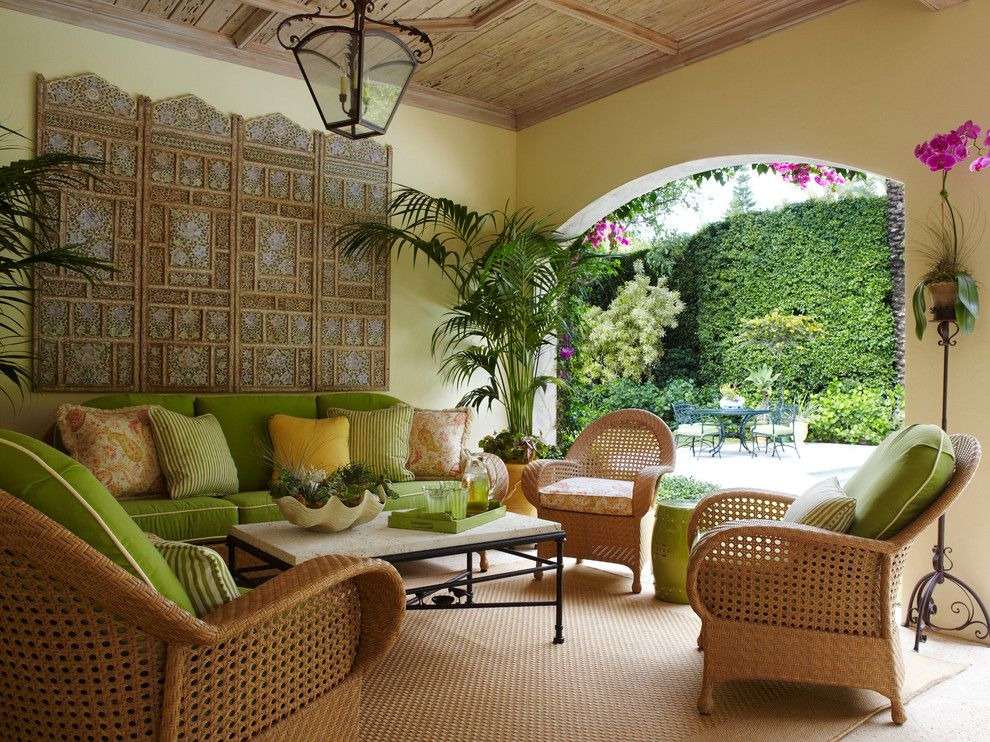
52. Interior design styles: Tuscan style
Tuscan-style interior design is decorated with warm, earthy colors like golden yellows, rusty oranges, deep purples and olive greens, much like those you’d find on a Tuscan hillside. Floors are bursting with detail and contain worn wood, terracotta tiles or mosaic inlay. Detailed antique rugs add a cozy element to the floors. Windows are always left unadorned so that natural light can easily penetrate and warm the interior.
Tuscan-style furniture borrows features from Mediterranean design with richly stained wood and intricate hand-painted patterns of natural elements such as flowers and fruit. Rooms are illuminated by hanging lights, candles and wrought-iron fixtures. The walls are decorated with artwork depicting wine bottles, cheese, fruit and flowers, while the ceilings have exposed beams.
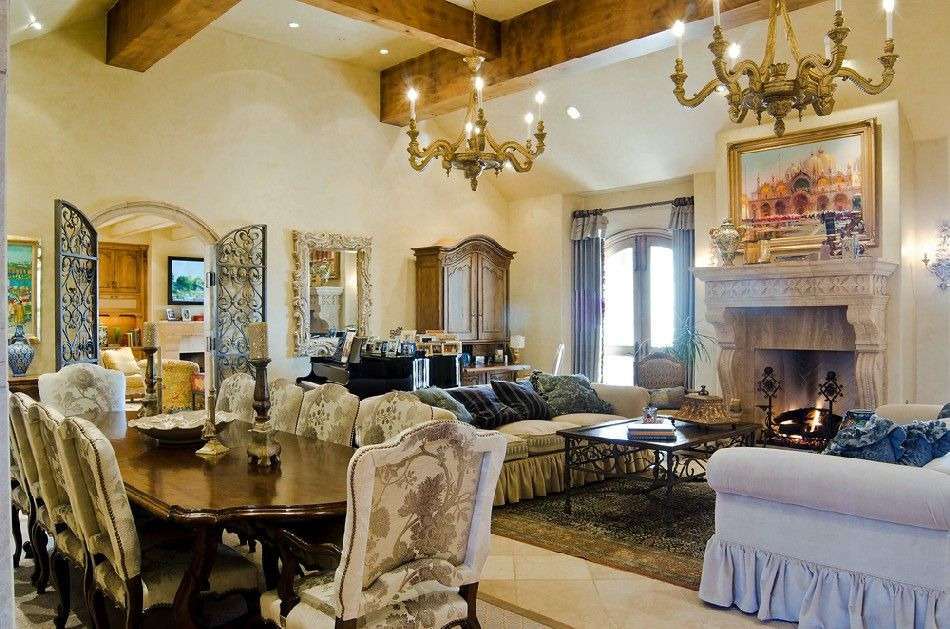
53. Interior design styles :Urban style
Urban-style interiors share a similar elegance to loft-style homes with a bit of rustic flair. Exposed brick and stone give character to the walls, and industrial pendant lighting in steel, copper and wrought iron illuminates all the vintage present throughout the home. Lighting is also an important element of urban style, as it breaks up the deep dark hues that clothe floors, walls and furniture. Floor-to-ceiling windows, used to keep the light in, are another classic feature of urban style. Furniture is composed of a mix of distressed and glossy woods to create a perfect balance between antique and industrial style.
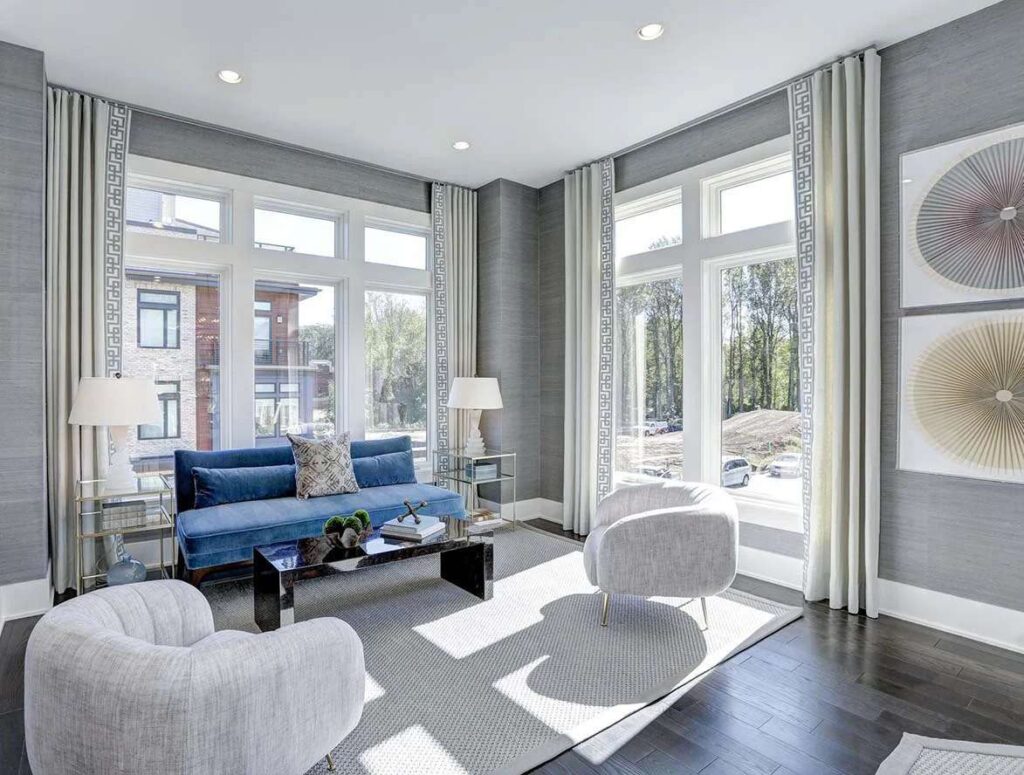
54. Interior design styles: Venetian style
Venetian-style interiors have a luxurious, enchanting ambience. Many elements of Venetian interiors have a gilded finish, including furniture and chair legs, mirrors, candleholders, frames and so on. Smaller collections of mirrors with ornate details are used as decorations and help the interior appear more spacious. Wall sconces are used to highlight mirrors and reflect light. Furniture is adorned with wooden details and sometimes covered with patterned fabric such as flowers or stripes.
The Venetian style offers a rich color palette of creams, deep reds, golds and purples. These shades are illuminated by an arrangement of white candles and large chandeliers. One of the most important characteristics of the Venetian style is the use of lancets in combination with Moorish decorative motifs and material influence.
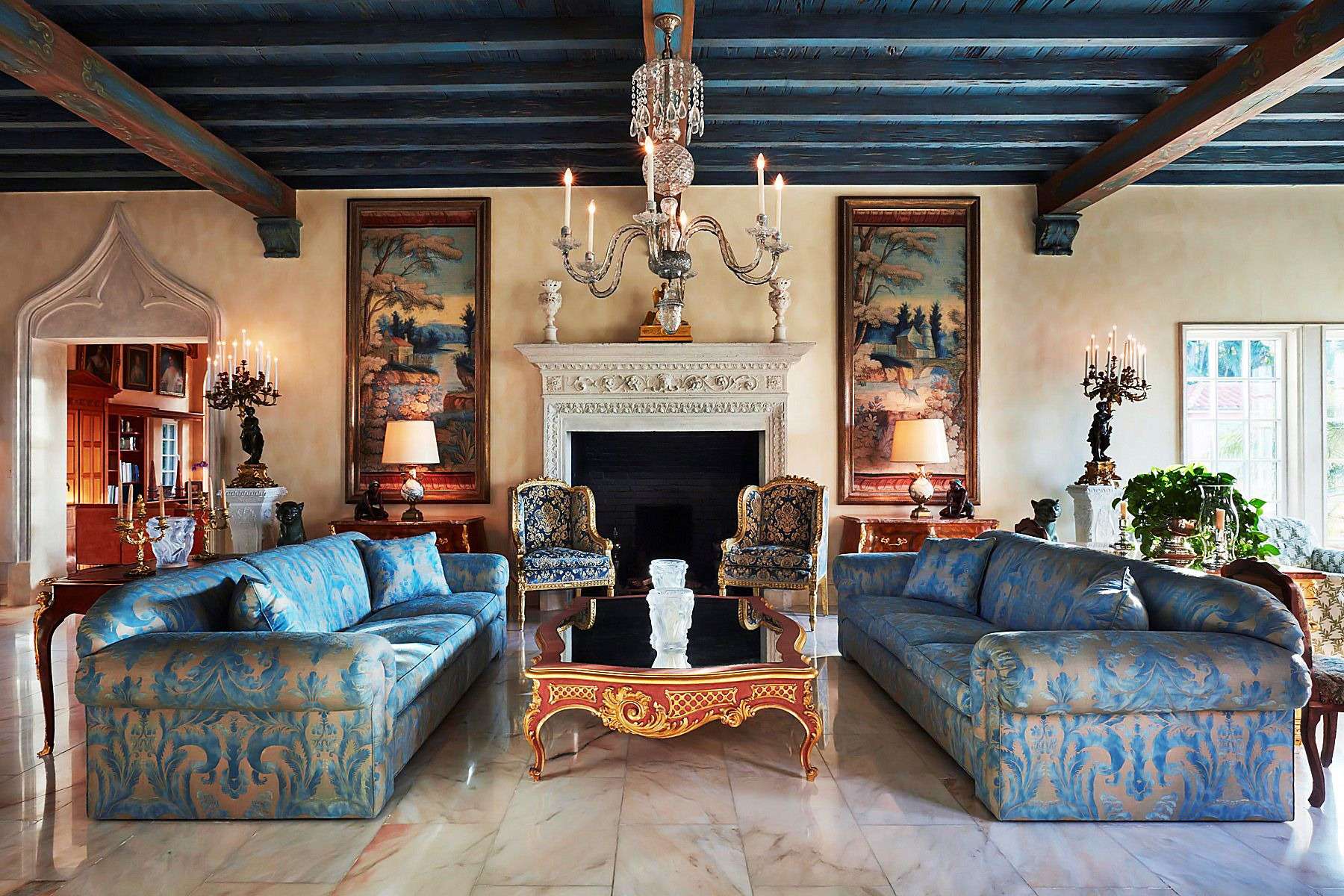
55. Victorian interior design style
Victorian interiors are based on ornamentation and timeless elegance. Homes from this period are generally divided into public and private spaces, with the living room being the main room for entertaining guests. Furniture is made from dark, glossy woods such as walnut, rosewood and mahogany. The backs, arms and legs of chairs and sofas are adorned with intricately carved floral motifs. A Victorian dining room is complete with regal fixtures such as extravagant chandeliers and often features a majestic, richly decorated sideboard.
Ceilings are equally ornate, with gilded details around the trim. Color palettes are similar to Venetian-style homes, and consist of teal, mustard yellow, lavender, walnut and rust red. Victorian trinkets, paintings and textiles add character to the interior.
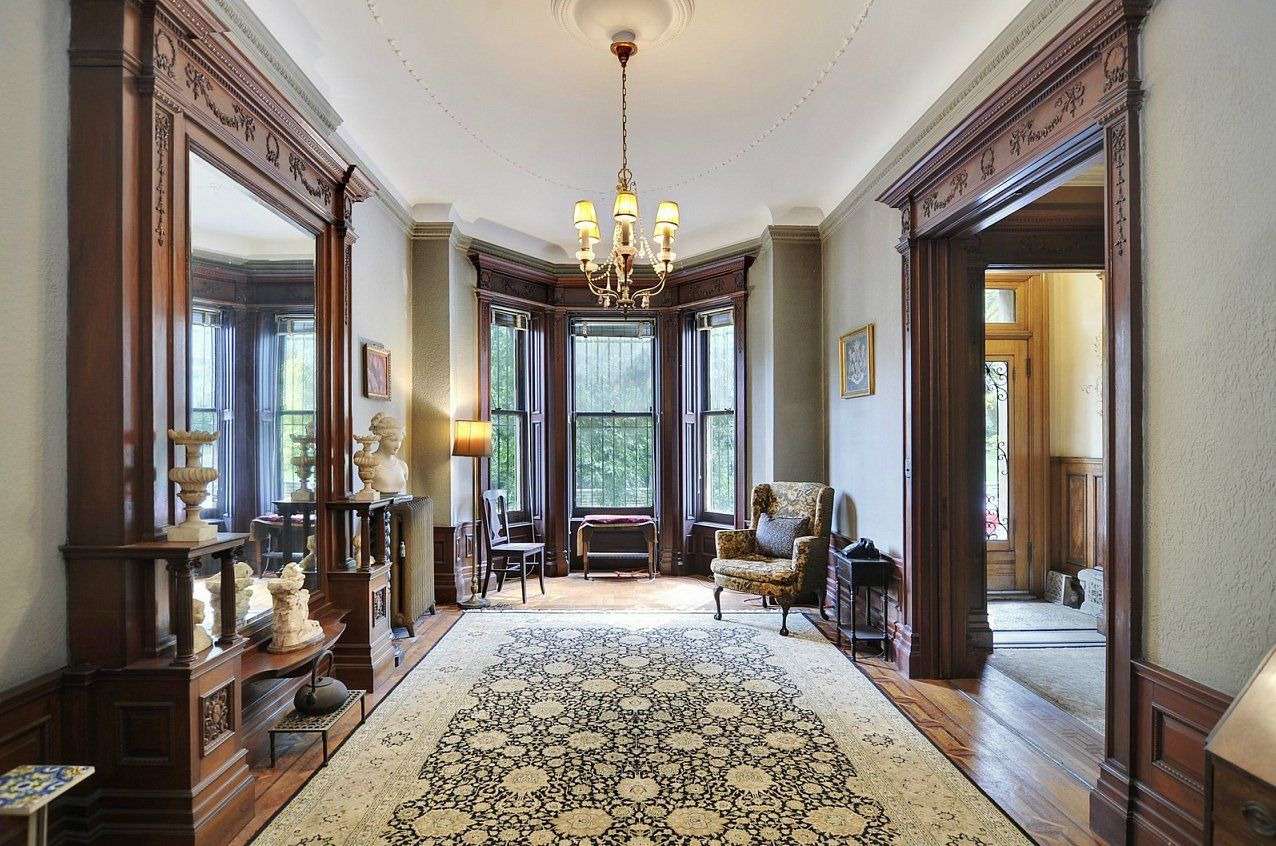
56. Interior design styles :Vintage style
Vintage style refers to the style of the 1940s and 50s and is accompanied by a nostalgic, comfortable ambience. Eclectic flea market finds can be displayed on open shelves, in decorative bowls or on shelves to add visual interest and character to the home. Other accessories that bring a vintage-style interior to life include old gilded mirrors, heavy cornice moldings, brass and frosted glass lamps and more. Bathrooms usually feature a cast-iron or porcelain clawfoot bathtub for an old-fashioned feel.
In the kitchen, various kitchen utensils and accessories such as toasters and antique coffee makers are left on the counters for an added vintage touch. In the living room, sofas and chairs are covered in detailed pastoral or floral motifs. Delicate lace curtains in soft white or neutral tones provide a soft accent that reinforces the vintage mood.
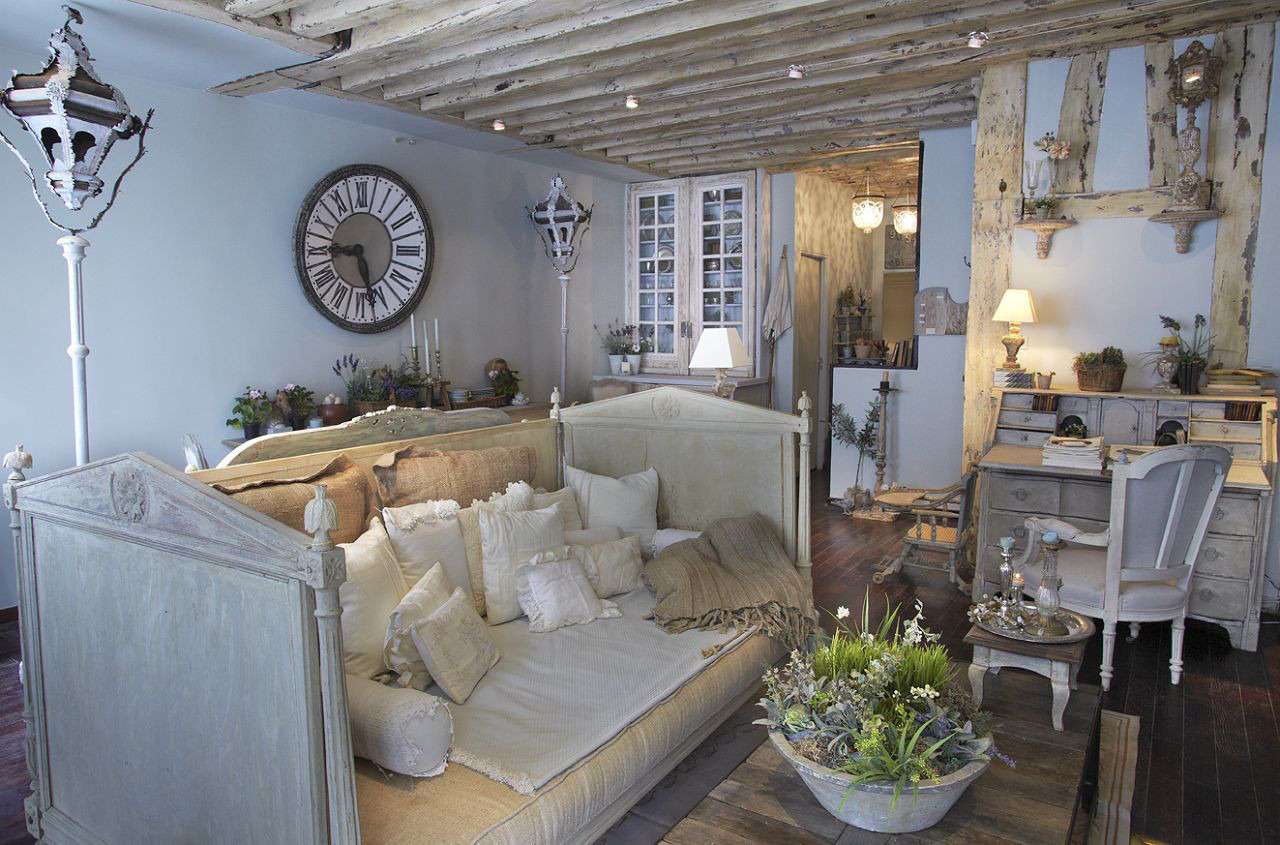
57. Interior design styles: Western style
Western-style interior design borrows from the characteristics of rustic Tuscan homes in that it features a warm color palette and lots of detail. Kitchens, for example, feature burnt orange terracotta tiles, and walls are decorated with engravings, colorful murals and mosaic tile backsplashes. Leather or hide armchairs and sofas are adorned with Navajo-inspired pillows and throws to add a splash of color and a Western touch.
This style features a striking palette of golden yellows, rusty oranges and deep reds to reflect the hues you might find in the painted desert. Accent lighting and ceramic pendants illuminate the rich color palette. Exposed ceiling beams are also common in this style, as are natural materials such as stone and granite. Fireplaces and large-scale mantels are central elements of this style, and are often constructed from rough-hewn stone.
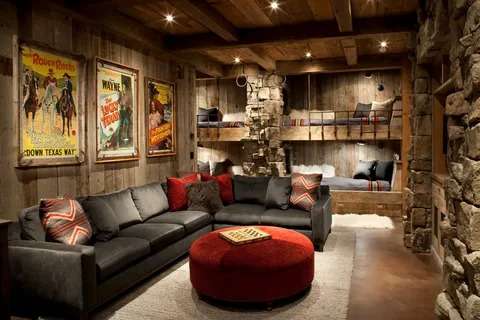
58. Interior design styles: Zen style
In Japanese, Zen refers to Buddhist meditation, so it’s not surprising that Zen-style interiors emphasize tranquility, harmony and relaxation. To maintain a subdued monastic atmosphere, Zen interiors are filled with earthy colors like beige, gray and off-white. Instead, the interior features a variety of textures to give character to the space, such as parquet flooring, cotton sofas and soft rugs.
Rugs usually match the floor color to reinforce the peaceful, serene aesthetic. Zen homes have floor-to-ceiling windows to bring as much natural light into the rooms as possible. Accent lighting such as bamboo sconces is used to illuminate artwork, mirrors or other wall decor. Zen-style furniture is natural and simple, with clean lines and no excess detail or embellishment.

home-designing.com|yandex
59. Interior design styles: Japandi style
Modern Japanese and Scandinavian interior design combine to create a new look: the Japandi style. The key elements of this style are clean lines, relaxed styling and a mix of materials that create a serene living space. Each aesthetic focuses on simplicity, soft hues, natural materials and comfort. It’s the intersection of modern Scandinavian and Japanese interior design styles. Both rooted in minimalist design principles, emphasizing warmth, natural elements and discreet color palettes.
With japandi, you won’t find ornate, showy details. Abundant natural light and plants are a key element of japandi interior design. The main materials used in this style are natural fibers, furniture made from natural materials and even handmade pottery and decoration.
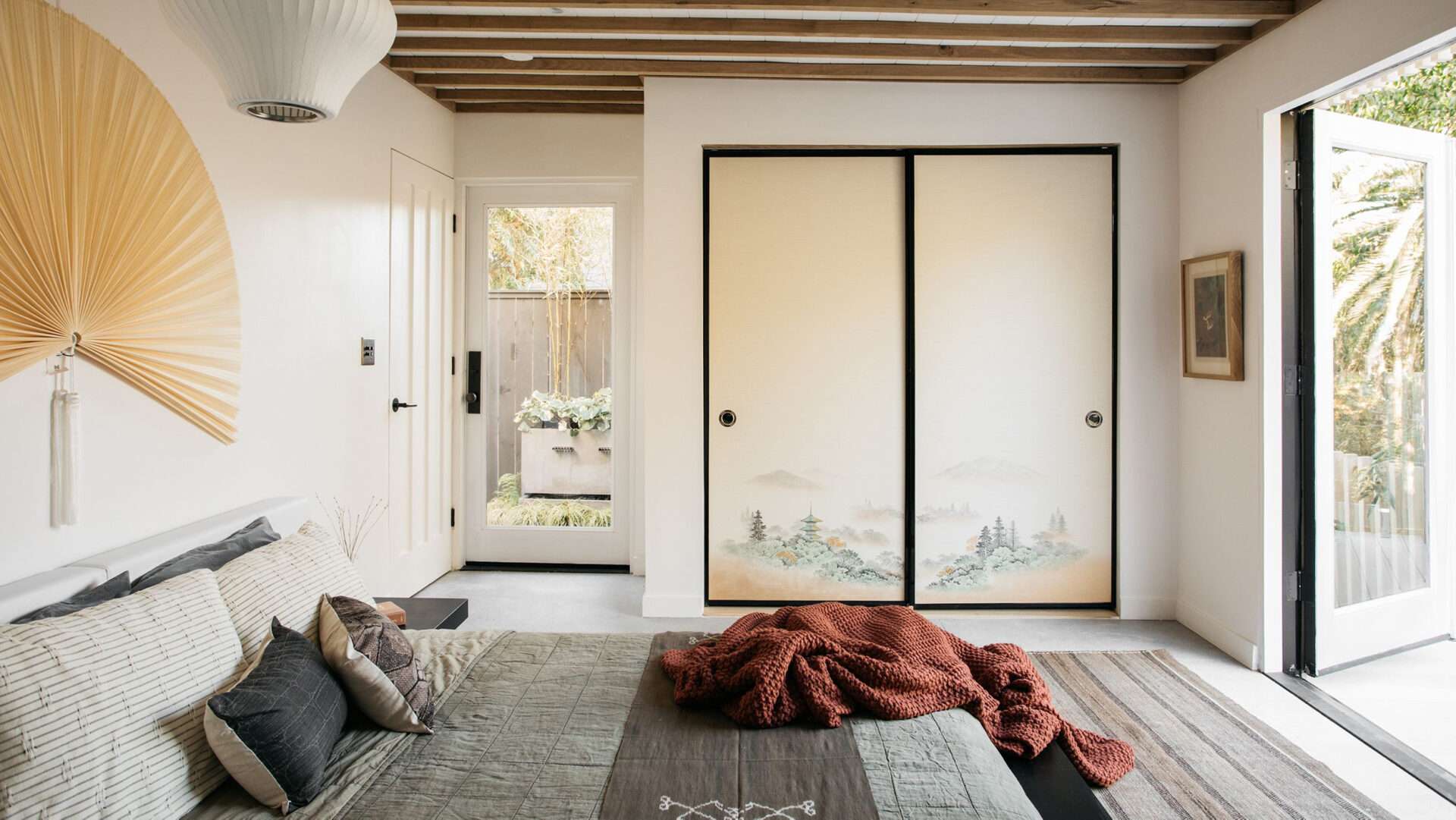
60. Interior design styles: Spanish style
Spanish-style interior design has much in common with the interior design styles of its Mediterranean neighbors. As a result, Spanish interiors share similar design elements with French country, Tuscan and Moroccan styles. This type of design features a coastal-inspired color palette of blues, greens, whites and browns. The warmth of terracotta reds and oranges is another major player in Spanish color palettes, due to the widespread use of terracotta tiles for floors and roofs.
Stone and ceramic elements are very common in Spanish style, as are pottery, wrought-iron pieces, candleholders and carved wood panels. Metallic copper accents are also important.
